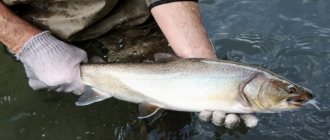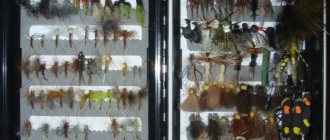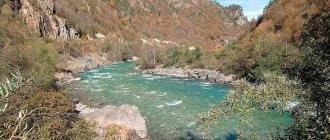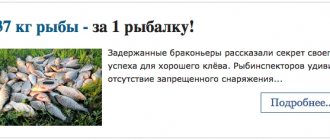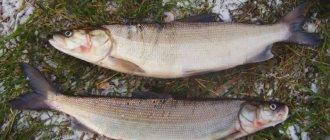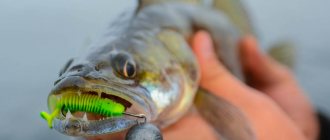Char
belongs to the salmon family. It can live in river waters, lakes, or can adapt to both. Prefers exclusively fresh water. Char is relatively small in size (50-60 centimeters) and weighs about a couple of kilograms. Initially, char gained its popularity in Europe, where it was loved for its juicy and tasty meat (calorizer). Small specimens of char are usually on sale, which are very convenient to prepare.
Description
Char
The head and body are slightly compressed laterally. The body ranges from slender in dwarf and sometimes small forms to dense, torpedo-shaped in large ones, covered with small scales. There are developed teeth on the jaws, palate and head of the vomer. The color ranges from silver to steel, with a greenish or olive tint on the dorsal part, with numerous small light spots on the sides. During the spawning season, the belly is often bright red or orange. In juveniles of large and small forms and adult dwarf fish from a number of populations, transverse dark stripes are clearly visible. The first rays of the ventral and anal fins in mature fish are often matte white.
Migratory loaches are large, up to 88 cm in length and 15 kg in weight, silver-colored fish with a dark blue back, their sides covered with rather large light spots. Entering rivers, they darken, the back becomes greenish-brown, the sides brownish, with a silvery tint and numerous red or orange spots. The belly is usually gray-white and only in spawning char is bright red or orange, the throat is white or orange, the pectoral, pelvic and anal fins are pink or red, with the exception of the front rays, which are usually milky white. Migratory char spawns in autumn and early winter; some fish probably in the spring. In some reservoirs, char spawning is very extended. In the Kara River and in the rivers of Novaya Zemlya, spring and winter races have been recorded for char.
Varieties
It is impossible to give an exact number of char species found throughout the world. Discussions often arise among scientists about which forms should be distinguished as species or subspecies of a race or population of one species. Within one species, loaches can vary greatly. Sometimes in the same lake there are several forms that differ markedly in feeding habits, size or color. In Central Europe, initially only lake char was native. There are now many more species and lake-like brook char exist.
Arctic char
(Salvelinus alpinus) is the ancestor of all loaches. It is found in the Arctic Circle region and forms an infinite number of local races and forms. Arctic char live in water bodies from Northern Asia, Europe, Greenland to the eastern and northern coasts of the American continent. Many populations are anadromous, migrating to fresh water for spawning and wintering. Among anadromous char there are very large specimens, weighing up to 10 kg, and sometimes more than 15 kg
lake char
(Salvelinus umbla) is the only native char in Central Europe. This is a legacy of the Ice Age, preserved to this day in alpine lakes and in the cold, deep waters of pre-alpine lakes. Until recently, it was considered a form of Arctic char, but today scientists consider it an independent species, citing Salvelinus umbla described by the famous biologist Carl Linnaeus. Lake char is characterized by the presence of several forms in one lake. These include wild char that grows to large sizes and medium-sized normal char that feeds on plankton, and slow-growing deep-seated char that feeds on invertebrate animals at the bottom.
Brook char
(Salvelinus fontinalis) of all the char bears the greatest similarity to the native brook trout in both habitat and behavior. Typical of this species is the trout-like or white pattern on the brownish to greenish background of the back and white-black edges on the dorsal, pelvic and anal fins. Brook char was originally found in the northeastern part of America. In Europe, several populations have been acclimatized, which are located in small, lime-poor streams. What allows brook char to survive here is their high resistance to acidic water and the fact that slow-growing individuals are able to migrate further upstream in streams than brook trout. In many cases, native trout populations are declining due to brook char, and there are areas where brook char have completely replaced trout.
Alsatian char
(Salvelinus alpinus umbla x Salvelinus fontinalis) - a cross between stream and lake char - grown in aquaculture and is almost never found in open water bodies. Its characteristics are characteristic of the parent species.
Pacific char
(Salvelinus malma) is widespread in the northern Pacific region. It received its English name from the character of Charles Dickens's novel - the woman Dolly, who wore colorful outfits. The northern form is found from Alaska to Kamchatka, the southern form lives all the way to the USA and Japan. Pacific char are very similar to arctic char, so it is difficult to tell them apart when they are found in the same place. Typically, Pacific is characterized by smaller dots, they are smaller than the pupil of the eye. Many rivers are inhabited by anadromous forms that follow the spawning routes of salmon and feed on their eggs, decomposing meat of fish that died after spawning, and fry. In some Arctic rivers, these loaches grow to very large sizes, more than 10 kg.
East Siberian char
(Salvelinus leucomaenis) is also known as kunja. It is found only in the Asian-Pacific basin in both freshwater and anadromous populations. Like brook trout, it has a color without red dots, which is why it is called White-spoiled char in English. The pattern of dots varies significantly depending on the distribution area of the fish between Japan and Kamchatka. Brown trout is a popular, highly resistant and large-growing by-catch of Pacific salmon hunts in the Russian Far East.
The so-called yellowmouth loach
(Salvelinus levamdovi) is considered a representative of a number of loaches that are found in the Russian Far East. This fish lives in some rivers flowing into the Sea of Okhotsk. It was described by scientists in the late 1980s. Even later, the longfin loach (Salvethymus svetovidovi) was discovered. discovered in a single lake in the north of the Chukotka Peninsula. This loach looks so strange that it has been assigned to a genus that includes several fish. Thanks to its very long paired fins and dwarf stature, it has adapted to life in the depths of a cold lake.
Habitat
Arctic char is an anadromous species. Its range covers the waters of the Arctic Circle.
However, during the spawning period, fish move to rivers and lakes:
- Norway.
- Spitsbergen.
- Siberia.
- New Earth.
- Alaska.
- Greenland.
- Kola Peninsula.
Arctic char is found in the Arctic Circle.
Sedentary species live in the Baikal basin, some lakes of the Alps and the Kola Peninsula.
They are smaller and do not migrate to the oceans:
- The Far Eastern red fish char lives in the rivers of the Amur Region, Khabarovsk Territory, Primorye, as well as in freshwater reservoirs of the Kuril Islands and Sakhalin.
- The Kamchatka species is found off the coast of the Okhotsk and Bering Seas. It can migrate to feed in the waters of the Pacific Ocean. Most of the population comes to spawn in the rivers of Kamchatka.
Diet
Loach fish The food of
adult loaches consists of juvenile cod (on the western coast of Novaya Zemlya), capelin, sand lance, sculpin, partly crustaceans, worms, larvae of Chironomidae (bloodworms), etc.; juveniles in fresh waters feed on Chironomidae larvae, mosquitoes and flies, crustaceans (Copepoda, etc.). Competitors include brown trout, lake trout and other salmon. The enemies of char are glaucous gulls on the lakes of Novaya Zemlya, which catch them from under the ice.
Adult char live in the sea, from where they enter the lower reaches of rivers for spawning and wintering. On the mainland (Kara Bay), char enters the rivers in July-August: on the islands of Medvezhy, Spitsbergen, Novaya Zemlya it enters in August-September, and the slope from lakes and rivers enters the sea in June-July.
Spawning
Arctic char is a typical cold-water anadromous fish, very characteristic of the Arctic region, breeding in fresh waters, but not rising high in rivers. Spawning of char occurs in the fall, in September-November in rivers (on Novaya Zemlya and Spitsbergen in lakes). The fertility of char is from 3 to 21 thousand eggs. Bottom caviar, up to 5 mm in diameter. In September, the fry reach a length of 2.5-8.5 cm (on Novaya Zemlya). Juvenile Arctic char spend the first two to four years in fresh water bodies.
Spawning occurs in shallow, fast springs, rivers and lakes on rocky pebble soil, near the shore, in places with relatively slow currents, at a depth of 13 to 46 cm. Like other salmon fish, the char makes a nest and buries eggs in the ground. Fish are distributed throughout the reservoir, choosing areas covered with fine gravel. At this time, they are very aggressive and defend their territory, attacking every object, especially those painted red. The loaches are then divided into pairs. The males jump at each other like roosters, with their fins protruding and their mouths gaping intimidatingly. At this time, females dig nests with sharp oscillatory movements of their tail. The female gives the signal for spawning: having dug a hole, she stops over it and trembles, releasing a portion of eggs. At the same time, the male releases milk. It is remarkable that the coloration, especially in males, changes dramatically. The cells containing dark pigment on the sides, back and head are apparently under the control of the nervous system. When the male circles around the female, the dark pigment is concentrated in the form of two longitudinal stripes on the sides of the body and one transverse stripe on the head between the eyes, the rest of the body becomes almost white, except for the fiery red belly.
Having spawned several portions of orange eggs, the female buries them and begins to build a new nest. Males are polygamous and can spawn with several females in turn. It is interesting that, having laid eggs, the female continues to dig unnecessary holes for some time, and often, together with the male, eats the newly laid eggs. At the same time, she defends her spawning area for several days, energetically driving away other fish. Spawning can occur both day and night.
Along with one large male, small, dwarf ones also take part in spawning. Loaches begin to spawn for the first time at the age of 5-6 years; their spawning, apparently, is not annual. The young spend 2-4 years in the river, after which they slide into the sea. But the char does not go far into the sea and stays mainly in the estuarine spaces, in the area of the river in which it was born. The duration of his stay at sea, as a rule, does not exceed 2-3 months. Migratory char is a predator that consumes juveniles of other fish and small fish. Not all char go to sea. A significant part of them spawn in lakes and streams and feed in large rivers. Lake-river charr are smaller than anadromous ones (35-45 cm) and differ in a number of morphological characters. They feed mainly on bottom mollusks and insect larvae. Lake forms of Arctic char are also widespread. They spawn and feed in lakes without going beyond their boundaries.
How does fish develop?
The life of char begins in lakes and clean rivers. The fry that emerge from the eggs actively feed, but are in no hurry to leave the fresh water body and live here for up to 2–3 years. After this, the juveniles descend along river beds to the sea, where they remain for 3 months. Here she gathers in large flocks, which makes it easier for her to hunt and helps her escape from larger predators. During migrations, metamorphoses occur in the fish's body, allowing loaches to live in salt water.
Resident char live in freshwater rivers.
Until 4–5 years of age, the juveniles grow and gain weight. Only after reaching this age do loaches go to spawn in the places where they were born. After spawning, they return to the sea. Resident char spend most of their lives in freshwater rivers and lakes and spawn in shallow waters and tributaries. Some of them may go to the seas to feed their masses, but then return to fresh water bodies.
Lifespan
The maximum age of anadromous char reaches 15 years. Fish that live in rivers and lakes rarely live to be 10 years old.
Spawning period
Resident char begins to spawn in the 2nd year of life. The breeding season for these species is April–May. Adults, ready for it, select flat areas of the bottom covered with pebbles and sand, make depressions in them and begin spawning. The female can produce up to 6 thousand eggs at a time. Some species lay their young on algae. Fertilized eggs are carried away during the spring flood of the reservoir into shallow water, where the hatched fry find a sufficient amount of food. Sedentary fish spawn up to 10 times in their life.
Anadromous species reach maturity by the age of five. The spawning period lasts from September to December.
At this time, mature individuals enter the rivers to spawn. Large females spawn up to 9 thousand eggs at a time. They spawn 3–5 times during their life.
Fishing
Char is of local commercial importance. It is caught in commercial quantities on Novaya Zemlya, in the Czech Bay and the lower reaches of the Kara River, as well as in the lower reaches of Siberian rivers (Ob, Yenisei, Lena). It was mined in more or less significant quantities on Novaya Zemlya and Kara Bay. Fish are caught using fixed nets. On Novaya Zemlya they use special fixed seines, cast seines, and fences to catch char. In recreational fishing, char is usually caught using a spinning rod.
It is quite possible to increase catches by developing fisheries in northern Russia. The fat content of char is 11.2%. The vast majority of the catch is salted, sometimes followed by cold smoking. A very small part of the catch is sold frozen or smoked (hot). In places of consumption, some of it is used to prepare natural canned food, since char is rated equally highly with brown trout. It can play a significant role in the Russian North (favorable areas for its cultivation are located along the Kola Peninsula) due to its high commercial value. In Norway, more than 500 tons of it are grown annually.
Fishing Features
Fishing for char
Since char is a predator, a spoon is mainly used to catch it. which the fish usually greedily grabs. Sometimes, instead of a spinning rod, when hunting a predator, you can take a regular float rod and a piece of fish fillet as bait.
From spring to late autumn, fish bite well on a worm, fly, or spinner. It should be caught during sunset and sunrise. At this time, the char begins to obtain food for itself and hunts insects falling into the water. In the cold season, the predator needs to be looked for in the depths of the reservoir, where it lives in search of larvae.
You should select gear for catching this fish depending on the characteristics of the reservoir. Knowing its habits, finding the habitats of the char will not be difficult. Then spinning anglers, float tackle lovers, and those who love winter fishing will have enough chances to catch their trophy.
| fish Balach loach |
| fish Balach loach |
Description. The body is ridged, low, covered with mucus. The head is small, slightly flattened on top. The snout is long and low. The mouth is small, lower. The lips are fleshy. There are 6 antennae around the mouth, 2 of them in the corners of the mouth, 4 at the end of the snout. There is no collapsible spike under the eye. The sides are covered with very small scales that do not overlap each other. The color of the body is variable, often yellowish-gray, brownish or golden, with dark spots of irregular shape on the sides and dark stripes on the fins. During the spawning period, the head, body and fins of males and females are covered with epithelial tubercles, and in males a leathery ridge is formed on the caudal peduncle. Males are usually larger than females and have longer pectoral fins. The caudal fin is rounded, almost without a notch.
Spreading. In the Middle Urals there are in the basins of Chusovaya, Ufa, Lozva and Mezhevaya Utka.
Age and size. A small fish, usually 10-15 cm, rarely up to 18 cm long and weighing 20-25 g. Maximum age 5-7 years.
Lifestyle. Char primarily lives in small rivers with a fast flow and a pebble bottom from source to mouth, but is also found in the lower reaches of large rivers. Inhabits flowing lakes, ponds, and reservoirs with a favorable oxygen regime; usually the char is the first to disappear from the fish population as soon as the reservoir is killed. Bottom fish. It feeds on aquatic invertebrates, as well as fish eggs and plant foods. In rivers it stays with the current, hides behind stones, grabbing insect larvae carried away by the current. In lakes and ponds in winter it burrows into silt. In damp soil it can remain alive for a long time. It leads a secretive lifestyle, feeding mainly at dusk and on cloudy days, because in small transparent reservoirs, pike, burbot, taimen, large grayling and fish-eating birds hunt for char. It lives alone or in small groups, which is more typical for juveniles. It becomes sexually mature in the third year of life with a body length of about 6 cm. Spawning is portioned, begins in the spring and continues in the first half of summer.
It is not abundant in its habitats everywhere; it usually has no commercial significance; it is sometimes used as food or as bait for catching predatory fish. In the mountain rivers of the Middle Urals, the density of char aggregations on riffles can reach 25 specimens/sq. m. Juvenile char easily get used to being kept in an aquarium. Char is interesting as an object for studying fish behavior. Sensitive to changes in atmospheric pressure: when it decreases, the fish often rises to the surface, capturing air, and slowly sinks to the bottom, therefore it is a good barometer.
Fishing for char. Char is caught mainly from spring to autumn, sometimes in winter. Tackle: float rod, bottom tackle, spinning rod, fly fishing, “Bolognese” fishing rod, in addition, some fishermen catch with a balda, a tackle that imitates a lot of insects falling into the water. In the summer after spawning, when the water warms up to 18 degrees, the char bites during the day from the bottom on light sensitive tackle. When the water reaches 22 degrees, it bites in the upper layers of the water, in the morning and in the evening, and the tackle must be immersed slowly so as not to spook the fish. You need to hook immediately, but not too much. In winter, char is caught from the bottom. Bait: a piece of fish meat, a worm, maggots and other insect larvae. No-bait fishing - using a spinner and a streamer fly. In the current it bites quickly and briskly; in still water the bites are barely noticeable. When playing, it resists strongly. It should be remembered that char is susceptible to helminthiasis, and heat treatment is required before eating it.
Benefits and harms
The undoubted benefit of char fish for human health is that its meat is rich in omega-3 (fatty acids), thanks to which our body develops protective functions in the fight against inflammatory processes. In addition, these substances prevent the formation of blood clots and blood clots, which, in turn, can become the main cause of a heart attack.
It has been scientifically proven and substantiated that one hundred grams of this fish contains the daily requirement of vitamin E with half of the vitamins B6 and B12 needed by the human body, as well as magnesium, iron and niacin. The benefits of char fish are obvious even when smoked or salted, since it contains an increased amount of a substance such as calcium.
Char is practically incapable of causing harm to human health. However, it is worth considering that this product can provoke allergic reactions. In addition, fish can also harm the body if it is caught in an environmentally unfavorable area. So before purchasing such a product, it would be a good idea to find out where the char was caught.
Recipes with char
Many delicious dishes are prepared from char. Many of the recipes are simple enough that even people with no cooking knowledge can master them.
Smoked char
To make char using the cold smoking method, you will need:
- fish – 1 pc.;
- cloves – 3 pcs.;
- lemon juice – 2 tbsp;
- bay leaf – 1 pc.;
- water – 1 l;
- allspice – 3 pcs.;
- salt – 4 tbsp;
- black pepper – 5 peas.
Char is made using the cold smoking method.
Cooking steps:
- Bring a mixture of water, salt, pepper, cloves and bay leaf to a boil, then cool and strain.
- Add lemon juice to the broth.
- Place the fish in a container, pour brine, press down and leave in the refrigerator for 24 hours.
- Dry the carcass with a paper towel and hang it tail down for a day at room temperature.
- Smoke fish at +25…+27 °C for 12 hours.
Rich ear
From this fish you can make a tasty and rich fish soup.
You will need:
- fish carcass – 1 pc.;
- potatoes – 2 pcs.;
- tomatoes – 1 pc.;
- water – 3 l;
- carrots – 1 pc.;
- onion – 1 pc.;
- greens – 1 bunch;
- vegetable oil – 1 tbsp;
- salt and pepper - to taste.
The fish soup turns out tasty and rich.
Cooking process:
- The loach is cut into portions and filled with cold salted water.
- Bring it to a boil, periodically removing the foam.
- After 20 minutes, remove the fish and strain the broth.
- Onions and carrots are chopped and then fried in oil.
- The potatoes are peeled, cut into cubes, and boiled in broth.
- Add the roast and fillet to the pan, and then cook the soup for another 3 minutes.
- Before serving, the fish soup is sprinkled with chopped herbs.
Salted char
Only chilled char is suitable for salting. It should be divided along the ridge into 2 halves.
Salt and sugar are mixed in a 2:1 ratio. For 1 kg of fish you will need 100 g of dry marinade. The carcass is placed in a container and sprinkled with the mixture. Close the container and put it in the refrigerator overnight. Shake off the remaining marinade from the fish and leave for another 12 hours. Before serving, cut it into pieces and sprinkle with herbs.
Salted char is a delicious seafood appetizer.
see also
|
|
|
